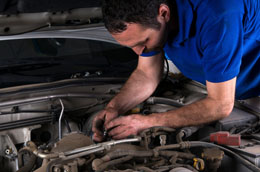
Every component of a complex machine has a limited service life, as wear and tear takes its toll over time. Your car’s shocks and struts are no exception to this rule. If you want to maintain or even improve the degree of riding control and comfort of your car, it’s essential that you know when it’s time to replace shocks, along with the struts which support them. Timely maintenance and replacement of car parts, when they are close to termination of service life helps avoid any car crisis from developing. The aim of writing this Buzzle article is to provide you with information about the proper time frame to replace your shock absorbers and struts.
Function of Shocks and Struts
Let me briefly acquaint you with the role played by shocks and struts in the functioning of your automobile, before talking about when to replace shocks. Both are a part of the car’s suspension, whose primary function is to create the shock absorbing buffer between its frame and the wheels. It also ensures that wheels remain in close contact with the road, providing you with a smooth ride and control over the car while accelerating, braking, and turning it.
The reason you don’t feel most of the road bumps encountered by your car wheels, is because the hydraulic shock absorbers or shocks, along with the struts, absorb the impact through a spring mechanism and dissipate it, before it gets transmitted to the car frame.
They also provide structural stability to the car suspension and provide you with more control while driving. When the shock absorber’s hydraulic mechanism leaks or the overall system undergoes damage, it’s no longer effective in providing driving stability and absorbing road shocks. Ergo, your ride is bumpy and your car sways more while driving. Let us see what are the signs that indicate an imminent shock absorber replacement.
Symptoms of Worn Out Shocks and Struts
When the shocks and struts are worn out, it’s difficult to ignore the problem as you can literally feel its effects, whenever your car hits a pothole or you take a ride on a bumpy road.
When the shock absorber mechanism is not working, the car front dives down when you hit the brakes. On the other hand, when you accelerate, you can distinctly feel the rear end of the car squatting. Rides become increasingly bumpy and the whole frame tends to bounce or oscillate up and down, after hitting a pothole. When turning, the car may sway excessively.
Also, if you find leaks on the shock absorber housing, find damaged piston rods, and excessively worn out tires, it’s time you got both the shocks and struts replaced. Knowing when to replace them is important and when you see any of the above signs, you can be assured that it is time to visit a repair center.
When to Replace Them?
Car manuals generally provide information about when to replace your shock absorbers. Generally, the recommended mileage range after which you are advised to go for a replacement is 50,000 to 60,000 miles. Whenever you notice any of the above mentioned signs of wear and tear, you need to go for a replacement. Refer to your car manual for specific details about the ideal replacement period.
The best way to determine replacement timing is through actual inspection. If you identify any signs of wear and tear, which were discussed before, it’s best you get the shocks and struts replaced as soon as possible, unless you enjoy roller coaster rides. Timely replacement will also ensure that your car tires and drive assembly are not significantly affected. However, if you insist on a time frame, it’s recommended that you inspect and replace them after a running of 50,000 to 60,000 miles.